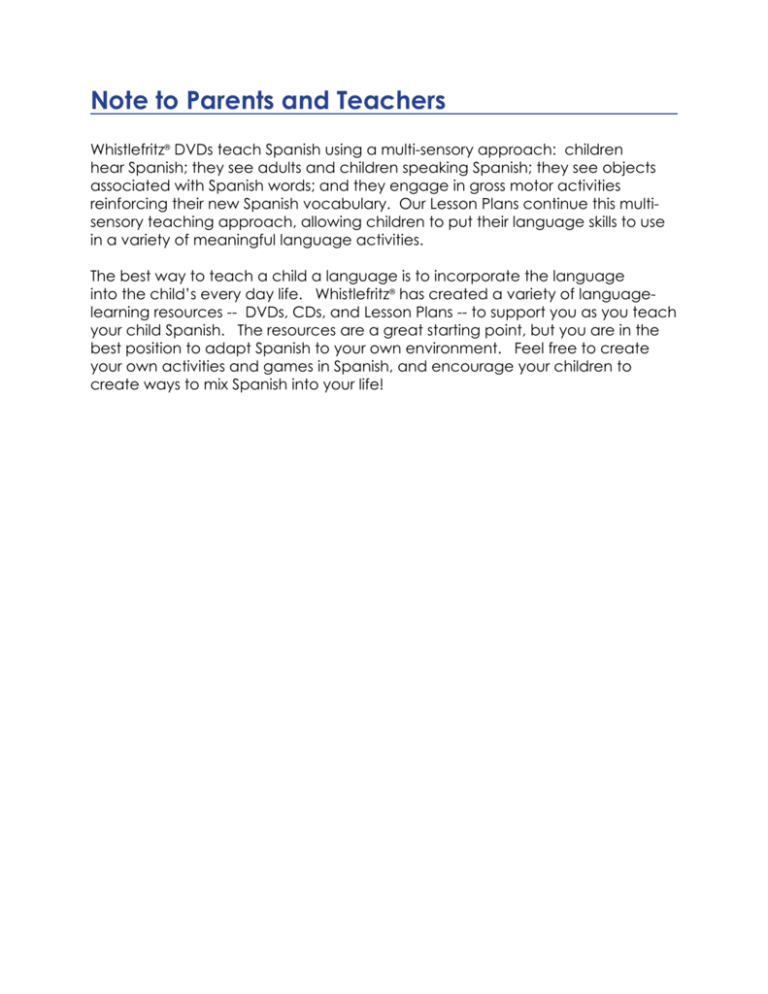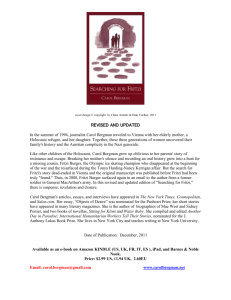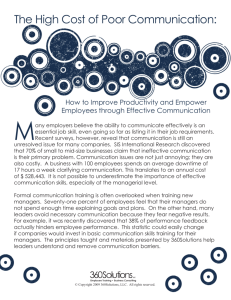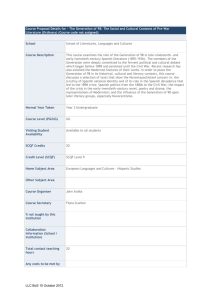the Free Lesson Plans
advertisement

Note to Parents and Teachers
Whistlefritz® DVDs teach Spanish using a multi-sensory approach: children
hear Spanish; they see adults and children speaking Spanish; they see objects
associated with Spanish words; and they engage in gross motor activities
reinforcing their new Spanish vocabulary. Our Lesson Plans continue this multisensory teaching approach, allowing children to put their language skills to use
in a variety of meaningful language activities.
The best way to teach a child a language is to incorporate the language
into the child’s every day life. Whistlefritz® has created a variety of languagelearning resources -- DVDs, CDs, and Lesson Plans -- to support you as you teach
your child Spanish. The resources are a great starting point, but you are in the
best position to adapt Spanish to your own environment. Feel free to create
your own activities and games in Spanish, and encourage your children to
create ways to mix Spanish into your life!
Mi casa
This lesson gives children an opportunity to practice words that they are learning in the
Whistlefritz® DVD Adentro y Afuera (Inside and Out).
Objective
• Learn Spanish vocabulary words for the rooms of the house (You can
integrate this lesson with your Social Studies curriculum! )
Materials
• Whistlefritz® DVD: Adentro y Afuera (Inside and Out)
• Worksheet: Mi casa
Time
20-40 minutes
Activity
1. Watch Adentro y Afuera (Inside and Out), from the beginning through the
end of the opening scene.
2. Pause the program when Fritzi’s house appears on the screen (shortly after
María says: “Vamos a conocer la casa de Fritzi.”)
3. Ask children to repeat the names of each of the rooms of the house after
María.
4. Ask children questions about their houses. Examples:
• ¿Qué se hace en [la cocina]? (What do you/does one do in the
kitchen?)
• ¿De qué color es tu [dormitorio]? (What color is your bedroom?)
• ¿Cuántos [baños] tiene tu casa? (How many bathrooms are in your
house?)
• ¿Hay una mesa en tu [cocina]? (Is there a table in your kitchen?)
• ¿Qué te gusta en tu [sala]? (What do you like about your living room?)
5. Give each child one copy of the worksheet: “Mi casa.”
6. Ask children to draw the different rooms of their houses.
7. Ask children to share their work with peers. Encourage children to use their
Spanish vocabulary when sharing.
©2010 Whistlefritz LLC
Variation (or 2nd Activity)
For 2, 3, and 4 year olds, you can alter the activity as follows:
1. Enlarge the worksheet “Mi casa.”
2. Cut out magazine pictures of the different rooms of the house.
3. Have children paste pictures instead of drawing them.
©2010 Whistlefritz LLC
la sala
el baño
©2010 Whistlefritz LLC
Dibuja las partes de tu casa.
Mi casa
la cocina
el dormitorio
¿Dónde está el queso?
This lesson gives children an opportunity to practice words that they are learning in the
Whistlefritz® DVD Adentro y Afuera (Inside and Out).
Objective
• Learn Spanish vocabulary for positional words* (You can integrate this
lesson with your Math curriculum!)
Materials
• Whistlefritz® DVD: Adentro y Afuera (Inside and Out)
• Dice template (pre-cut and assemble one template for each child)
• Fritzi cut out
• Cheese cut out
Time
30-50 minutes
Activity
1. Watch Scene 3 of Adentro y Afuera (Inside and Out), where María is
searching for Fritzi in the kitchen.
2. Encourage children to point to Fritzi when they see him and say “allá” or
“está allá.”
3. After María finds Fritzi, ask children which positional words they remember
from the scene.
4. Have children cut out the Fritzi and Cheese cut outs.
5. Have children color the dice.
6. Explain to children that they will now play a game called “¿Dónde está
el queso?” Have children place the Fritzi and Cheese cut outs in front of
them. Have each child roll a die and move the cheese to the location
indicated by Fritzi on the die (i.e. If the die indicates “debajo”, the child
places the cheese under Fritzi.)
7. Have children ask and respond to the question: “¿Dónde está el queso de
Fritzi?” Ex: “El queso está [debajo] de Fritzi.”
8. Repeat the game as time permits.
* Note: Several of the positional words in this lesson and the next lesson seem similar, but
are used differently. The words in the first lesson (“delante”, “detrás”, and “debajo”) are
prepositions, while the words in the second lesson (“adelante”, “atrás”, and “abajo”) are
adverbs. Ex: El queso está delante del tazón. (The cheese is in front of the bowl.) Pongo el
queso adelante. (I am moving the cheese forward.) In these lessons, it can be helpful to think of
the first group of words as indicating a fixed position and the second group as indicating motion.
©2010 Whistlefritz LLC
Enrichment
1. Tell children that you are going to play a game called “Espío” or “I spy.”
2. Take a walk outside and “spy” different objects. “Espío un pájaro arriba.”
3. Keep “spying” objects using all the positional words in Spanish.
©2010 Whistlefritz LLC
Cheese Cut Out
Fritzi Cut Out
©2010 Whistlefritz LLC
©2010 Whistlefritz LLC
delante
debajo
encima
detrás
dentro
al lado
A Bailar
This lesson gives children an opportunity to practice words that they are learning in the
Whistlefritz® DVDs Adentro y Afuera (Inside and Out) and Vamos a Jugar (Let’s Play).
Objective
• Learn Spanish vocabulary for positional words and body parts
Materials
None
Time
30-50 minutes
Activity
1. Watch Adentro y Afuera (Inside and Out), and sing and dance along to
the song “El baile de las manos.” (You can skip directly to the song by
selecting the “Songs” option from the DVD menu.)
2. Encourage children to sing the positional words more loudly: arriba…
arriba…/ abajo…abajo…
3. After the song, ask children which positional words they remember from
the song.
4. Gather children in a circle. To the tune of the “Hokey Pokey”, have
children sing and dance along as follows:
Pon tu {mano} [adentro],
Pon tu {mano} [afuera],
Pon tu {mano} [adentro] y muevete al compás
Haz el Hokey Pokey y da una vueltecita
Y vuelve a comenzar!
Repeat verses substituting different parts of the body. Repeat verses substituting
different positional words.
©2010 Whistlefritz LLC
A Comer
This lesson gives children an opportunity to practice words that they are learning in the
Whistlefritz® DVD Adentro y Afuera (Inside and Out).
Objective
• Learn Spanish vocabulary words for foods. (This lesson will help students
improve their fine motor skills.)
Materials
• Whistlefritz® DVD: Adentro y Afuera (Inside and Out)
• Worksheet: ¿Qué te gusta?
• Flashcards (for enrichment activity)(Print 2 sets of each card)
Time
20-40 minutes
Activity
1. Watch Adentro y Afuera (Inside and Out), beginning when María is in the
kitchen. (This kitchen segment follows the song “El baile de las manos.”)
2. Watch the entire kitchen segment, pausing before the song “El frutero.”
Encourage children to repeat the vocabulary along with María and her
friends.
3. After watching the segment, ask children which words they remember.
(You can use the flashcards to refresh their memory.)
• la fresa (strawberry)
• el plátano (banana)
• la naranja (orange)
• la zanahoria (carrot)
• las uvas (grapes)
• el queso (cheese)
• el hueso (bone)
• el perro (dog)
• el ratón (mouse)
4. Give each child one copy of the worksheet ¿Qué te gusta?
5. Ask children to help Fritzi and his friends find their favorite foods by drawing
a line from each animal to the food the animal likes to eat.
6. Ask children to answer the question “¿Qué le gusta comer [al perro]”?
Answer: “Al perro le gusta comer [el hueso].”
©2010 Whistlefritz LLC
Enrichment
“Memory game”
1. Cut out the flashcards and place them face down.
2. Have the first child turn over one card. Have the same child turn over a
second card. If the cards match, the child can keep the cards. If the
cards do not match, the cards are placed face down again.
3. Encourage children to say the words on the cards as they turn them over.
©2010 Whistlefritz LLC
¿Qué te gusta?
©2010 Whistlefritz LLC
la fresa
el plátano
©2010 Whistlefritz LLC
la naranja
la zanahoria
©2010 Whistlefritz LLC
las uvas
el queso
©2010 Whistlefritz LLC
el hueso
el perro
©2010 Whistlefritz LLC
el ratón
el caballo
©2010 Whistlefritz LLC
Las frutas
This lesson gives children an opportunity to practice words that they are learning in the
Whistlefritz® DVD Adentro y Afuera (Inside and Out).
Objective
• Learn Spanish vocabulary words for fruit (You can integrate this lesson with
your Science curriculum!)
Materials
• Whistlefritz® DVD: Adentro y Afuera (Inside and Out)
• Template: Las frutas (Print the necessary quantity before the lesson)
• Construction paper or card stock (Ahead of time, cut a band
approximately 1 to 1 1/2 inches wide and approximately 22 inches long for
each child.)
• Flashcards (for enrichment activity)(Print 2 sets of each card)
Time
Approximately 40-55 minutes
Activity
1. Watch Adentro y Afuera (Inside and Out), beginning when the basket of
fruit, Fritzi, and the words “Las frutas” appear on screen.
2. Watch the entire fruit segment, including the song “El frutero.”
3. Encourage children to repeat the vocabulary with María and her friends
and sing along with Jorge to the song “El frutero.”
4. After the fruit segment, ask children which words they remember. (You can
use the flashcards to refresh their memory.)
5. Ask children about their favorite fruits. (“¿Cuál es tu fruta favorita?”
Answer: “Mi fruta favorita es [la manzana].”)
6. For this lesson, children will be making a headband.
7. Allow children to choose the fruits that they want to include in their
headband.
8. Ask children to color and cut out fruits from the “Las frutas” template.
9. Ask children to glue or staple the fruits on their headbands and to connect
both ends of the band together in order to fit their head.
10.Give children the opportunity to share and practice their new vocabulary
by showing their headbands to their friends and describing the fruits on
their headband. Ex: “Mi vincha tiene [una manzana] y [una fresa],” or
simply “Tengo una [fresa] y una [manzana].”
11.Now you can dance and sing along to “El frutero” again!
©2010 Whistlefritz LLC
Enrichment
Make a fruit salad!
Additional Enrichment
“Memory game”
1. Cut out the flashcards and place them face down.
2. Have the first child turn over one card. Have the same child turn over a
second card. If the cards match, the child can keep the cards. If the
cards do not match, the cards are placed face down again.
3. Encourage children to say the words on the cards as they turn them over.
©2010 Whistlefritz LLC
Las Frutas
©2010 Whistlefritz LLC
las uvas
la piña
©2010 Whistlefritz LLC
la manzana
la sandía
©2010 Whistlefritz LLC
el melocotón
la ciruela
©2010 Whistlefritz LLC
el limón
la cereza
©2010 Whistlefritz LLC
el melón
la frambuesa
©2010 Whistlefritz LLC
¿Qué te gusta comer?
This lesson gives children an opportunity to practice words that they are learning in the
Whistlefritz® DVD Adentro y Afuera (Inside and Out).
Objective
• Learn the Spanish vocabulary words for various foods
Materials
• Whistlefritz® DVD: Adentro y Afuera (Inside and Out)
• Template: Comida (Print the necessary quantity before lesson)
• Booklet: ¿Qué le gusta a Fritzi? (Print and assemble booklets ahead of
time.)
Time
Approximately 40-50 minutes
Activity
1. Watch, sing and dance along to the song “Comida.” (You can skip
directly to the song by selecting the “Songs” option from the DVD menu.)
2. Encourage children to sing the vocabulary words for the different types of
food more loudly: manzana…manzana../ pollo…pollo…
3. After the song, ask children which words they remember from the song.
(You can use the flashcards to refresh their memory.)
• brécol/brócoli (broccoli)
• manzanas (apples)
• maíz (corn)
• pan (bread)
• limones (lemons)
• pollo (chicken)
• duraznos/melocotones (peaches)
• uvas (grapes)
• ciruelas (plums)
4. Ask children about their favorite foods. (“¿Cuál es tu comida favorita?”
Answer: “Mi comida favorita es [la manzana].”)
5. In this lesson, children will be making a booklet. “¿Qué le gusta a Fritzi?”
(What does Fritzi like?)
6. Ask children to color and cut the foods and paste them on the correct
page using the vocabulary from the DVD.
7. Ask children to complete the sentences in the booklet.
©2010 Whistlefritz LLC
8. Encourage children to read their booklets to family members or friends!
©2010 Whistlefritz LLC
¿Dónde está?
This lesson gives children an opportunity to practice words that they are learning in the
Whistlefritz® DVD Adentro y Afuera (Inside and Out).
Objective
• Learn the Spanish vocabulary for “positional words” (Great activity for
toddlers to 1st graders!)
Materials
• Whistlefritz® DVD: Adentro y Afuera (Inside and Out)
• Toy (hide it before the start of the lesson)
Time
20-40 minutes
Activity
1. Watch Adentro y Afuera (Inside and Out), singing and dancing along
to the hiding song “Escondidos.” (You can skip directly to the song by
selecting the “Songs” option from the DVD menu and skipping to #5.)
2. Encourage children to sing and repeat the numbers in the song.
3. After the song, ask children to practice counting in Spanish.
4. Tell children that you need their help in finding a missing toy.
5. Ask them: “¿Dónde está mi juguete? ¿Está arriba? ¿Está abajo? ¿Está
encima? ¿Está al lado?”
6. Remember to use body motions when you use the Spanish positional
words.
7. As the children call out suggested directions, follow their directions to try to
find the toy.
8. Continue to follow the directions until you’ve found the toy.
©2010 Whistlefritz LLC


![Your_Solutions_LLC_-_New_Business3[1]](http://s2.studylib.net/store/data/005544494_1-444a738d95c4d66d28ef7ef4e25c86f0-300x300.png)


